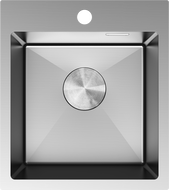
Choosing the right bathtub for your bathroom is just the beginning. To take care of aesthetics – to properly hide its legs, pipes, and drain – an appropriate enclosure will also be needed. There are many solutions available. The construction can be finished with tiles, wood, it can be more practical or less so. It is also a matter of individual preference. Check out what type of enclosure to choose for a corner bathtub. Fortunately, there are many options available on the market, such as ready-made enclosures. You can choose from many design options. Some of them are more practical, others less so.
Ready-made panels – enclosure for a corner bathtub
Perhaps the simplest solution that immediately comes to mind is removable covers. Such a bathtub enclosure is a ready-made solution that is attached to special supports. Fasteners can also be used for mounting. These enclosing panels are attached directly to the edge of the bathtub and the wall. There are many types available on the market, and they can be made from various materials, and come in different colors and patterns. It is best to order such panels directly from the bathtub manufacturer. This way, they will be the most compatible. If the bathtub is positioned against the wall edge – the entire area can be enclosed using two panels. Moreover, their connection will even be invisible. Such a bathtub finish is primarily easy, quick, and convenient. Its practicality lies in the simplicity of potential renovation. In case of any malfunction, disassembly of the enclosure will be incredibly simple.
Polystyrene is a solution generally intended for enamel bathtubs that do not retain heat. You can apply a finish made of ceramic tiles or plaster with waterproof properties on polystyrene, which can also have decorative features.
The enclosure for a corner bathtub made of polystyrene is designed for a specific type of bathtub. Therefore, you should decide on it before choosing a model. Before purchasing, make sure with the manufacturer that they have possible polystyrene enclosures in their assortment. Interestingly, this type of enclosure for a corner bathtub has many advantages: it prevents the water from cooling too quickly, and also has soundproof properties. Additional covers that can be ordered allow for the creation of shelves. This is an incredible convenience and saves space in the bathroom.
Enclosure for a bathtub made of drywall
It may not be one of the easiest options, but it is one of the more popular solutions. A drywall enclosure involves installing an appropriate frame onto which waterproof drywall panels will be mounted. Fiberglass panels can also work in this role. To ensure stability, UD profiles are used, which are mounted to the substrate. Vertical CD profiles are then mounted to them. These have a height that allows for a bathtub to be properly enclosed, usually not exceeding 40 cm. Interestingly, such solutions can also be used for oval bathtubs. In such cases, flexible panels or regular ones can be chosen, which, however, need to be bent wet beforehand. Only a prepared enclosure can be covered with mosaic, bathroom tiles or other materials characterized by waterproof properties.
Concrete blocks are among the most durable solutions. They are combined with each other using adhesive mortar. Such a built enclosure can also be finished with decorative plaster or covered with ceramic tiles. Increasingly, leaving the enclosure in its raw state is becoming a popular solution. In this case, the surface is impregnated, and the bathtub maintains its cool and dignified character. Due to the nature of the work, such enclosures are rarely used for oval bathtubs. Setting blocks in curved lines is quite time-consuming and requires appropriate cutting. For this reason, such a solution is recommended only for straight bathtubs.
Stone for a bathtub enclosure? An original bathtub enclosure
Stone is a natural material that fits perfectly into bathrooms that refer to organic forms. Stone enclosures are durable, aesthetic, and noble solutions. This is a solution for homeowners who love unconventional solutions and cannot stand limitations. Stone has no constraints like those imposed by one-dimensional tiles. Additionally, there is no need to focus on joints, which need to be cleaned regularly.
For mounting, the stone gluing technique is now commonly used, which relies on the use of dust produced during cutting. In this way, the connections between stones are exactly the same color as the material. This is an extremely practical solution. Moreover, it is virtually inconspicuous.
What type of stone to choose for a bathtub enclosure depends, of course, on personal preference. However, it is best to order it from the enclosure contractor or from a stone wholesaler. Before starting work, it is worth closely examining what such a ready-made solution looks like in a bathroom. Granite with a crystalline texture works best in this role. It is a hard and dense stone. It is characterized by the greatest durability and resistance, but it is not particularly attractive visually, which is why customers sometimes decide on another type of material.
If you need more information about arranging a bathroom interior, furnishing the entire room, or choosing an optimal enclosure for a corner bathtub, check out all the publications on our blog. In our texts, we provide advice on what type of bathtub enclosure to choose, how to use concrete block structures, and how an ideal bathtub enclosure should present itself.


















